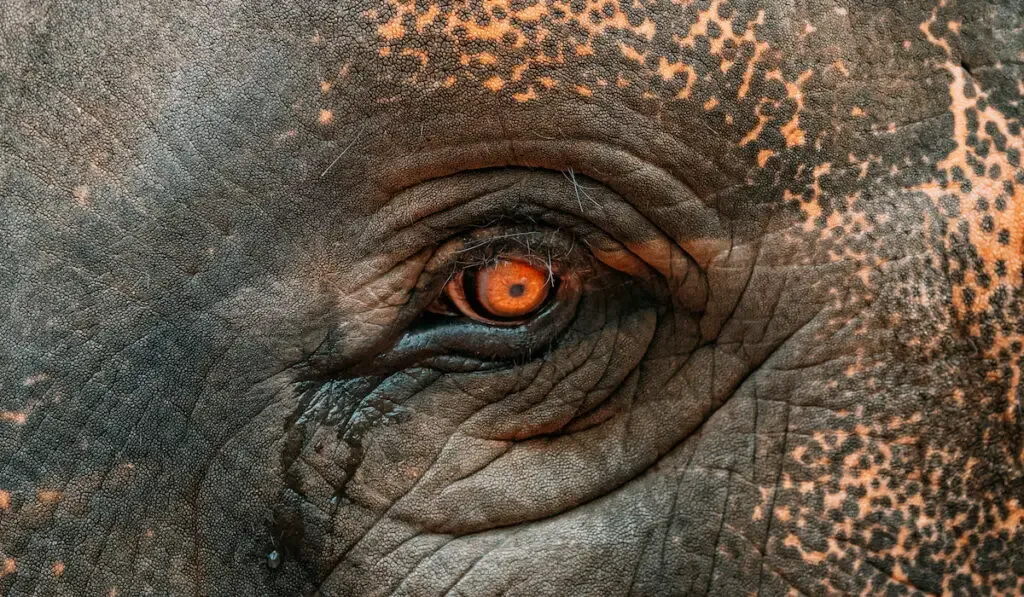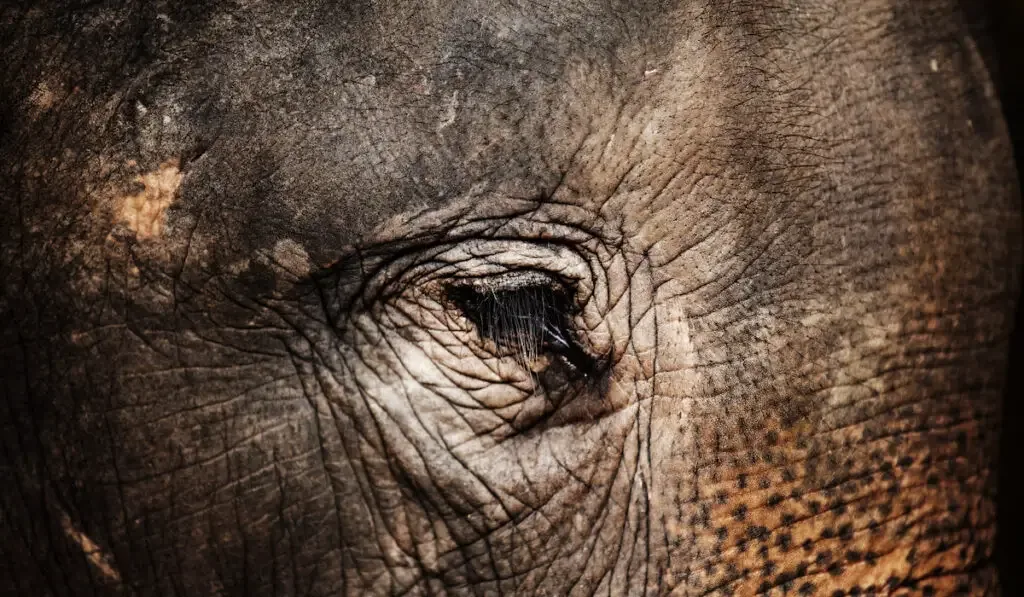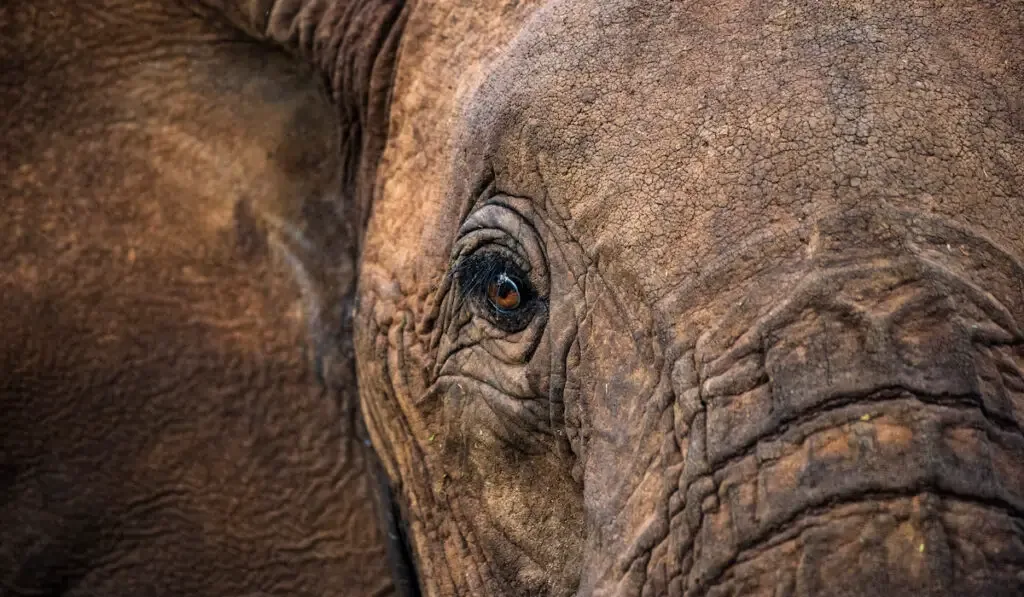All living creatures, big and small, have a different view of the world around them. While some of these animals can see the same way humans do, the rest have limited vision. One of the animals with a different view of the world is the elephant.
Elephants have a vision that has been instrumental in their survival and navigation of forests and savannas. Their eyes and eyesight are crafted in a way that is markedly different from what you would probably expect.

How much do elephants depend on their vision? Here are some interesting facts about the eyes and vision of an elephant.
Table of Contents
What Color Are Elephants’ Eyes
Elephants have amazing eyes that come in various colors. Their most common eye colors are dark brown, light brown, honey, and gray.
Besides those stated above, elephants have several other eye color possibilities including blue-gray, gold, green, and yellow. In very rare instances, some elephants have differently colored right and left eyes.
Can Elephants See Color?
Coupled with the fact that they have poor vision, elephants are also color blind. They have only two types of color sensors during the day; these sensors are the green and red cones.
Color-blind elephants tend to have the same set of visual pigments as color-blind humans. Although they can see blues and yellows, elephants cannot distinguish between reds and greens.
Elephants have what researchers call arrhythmic vision. This is a type of vision that changes with time. At night elephants are more sensitive to blue and violet lights, and this allows them to see more easily when there is little light.
How Many Eyes Do Elephants Have?
Just like every other animal, elephants have two eyes, but interestingly they have three eyelids. They have the regular upper & lower eyelid and a third eyelid that moves across the eye.
The eyelids help protect the elephant’s eyes while it feeds, bathes, and cools down.
In addition to having three eyelids, elephants also possess very long eyelashes. These lashes play an important role in keeping particles such as dust, sand, and debris out of the elephant’s eyes.
How Big Are Elephants’ Eyes?
Despite their massive size, the eyes of an elephant are not as big as one would expect. The African Elephant, for example, stands at about 8.2 to 13 feet tall and weighs about 5000 to 14000 lbs. But its eyes measure just about 3.8cm (1.5 in) in diameter.
When compared to the human eye, the elephant eye is only slightly bigger. The human eye measures around 2.5cm (1 in) in diameter.
Why Elephants’ Eyes Are So Small Compared to Their Head
The most probable reason why elephants have small eyes is that they have big ears and a refined sense of smell.

Elephants rely more on their sense of smell and hearing than on their eyesight to navigate around their environment. These other senses help to make up for their poor eyesight.
How Good Is an Elephant’s Eyesight?
Elephants have relatively poor eyesight. Elephants eyes are located on the side of their heads. With their eyes in this position, they have better peripheral vision.
However, elephants lack depth perception, and their vision is largely limited. They are generally short-sighted and can only see distances up to 25 feet.
Elephants are usually born blind. In the early stages, they rely on their other senses to help navigate their way around their new world.
As their vision begins to improve through the years, they use it to seek out food and keep an eye on other calves. However, the eyes of an elephant will remain small, and at best, it will provide moderate vision.
When there’s drought in the wild, elephants journey long distances to find new sources of food and water. There is a higher chance of them smelling or hearing the water than actually seeing it.
Elephants can see better when under shade. But under the full sunlight of open savanna, their sight is markedly unremarkable.
Elephants that have adapted to staying under shade develop rounder pupils because of the reduced exposure to sunlight.
Some elephants usually have a white ring around their iris as they get older. The ring bears similarities to the age ring that we humans have as we grow older. These rings are called arcus lipoides, and they do not disturb their vision.
Elephants usually spend a lot of time eating and will always stay up at night to get enough food. They barely have more than two hours of sleep at night.
With them having to spend most of their time in the dark, elephants have been able to adapt their eyes to see when there is limited exposure to light. This enables them to forage out of the heat of the sun, although they have to sacrifice their daytime vision.
Do Elephants Have Tear Ducts?

Tear ducts, which are usually found in humans and other mammals, help to drain tears out of the eye as they flush out dirt. Being mammals, you would expect elephants to have tear ducts, but they do not.
Instead of a tear duct, elephants have what is called a nictitating membrane.
The nictitating membrane is located in the elephants’ third eyelid. It is responsible for producing the fluid in the aqueous layer of their eyes. So, it functions somewhat like a tear duct.
Conclusion
Elephants have relatively small eyes that can come in several different colors. They see more clearly at night although it is still not their strongest sense. Although they are color blind and don’t have extremely keen vision, Elephants have other very strong senses like hearing and smell that make up for this deficiency.
Resources
- https://jabulanisafari.com/through-the-eyes-of-an-african-elephant/
- https://seaworld.org/animals/all-about/elephants/senses/
- https://www.victoriaeyecenter.com/elephant-eyes/
- https://www.4elephants.org/blog/article/6-facts-about-an-elephants-eye-vision
- https://www.quora.com/Why-such-a-big-animal-like-the-elephant-has-very-small-eyes
- http://chimpandsee.blogspot.com/2017/01/elephanttuesdays-elephants-vision.html
- https://www.whyanimalsdothething.com/elephants-dont-cry
- https://theconversation.com/elephants-are-sensitive-and-very-social-but-there-is-no-evidence-they-cry-29241
